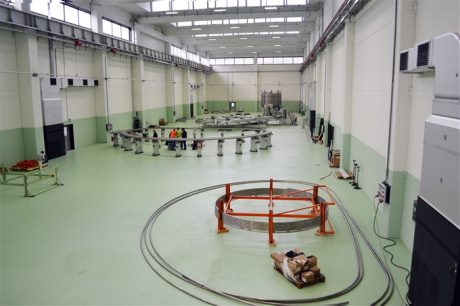Contracts for the construction of seven key buildings, plus a contract for the power supply for a plasma heating system, and progress on the manufacture of a major component signal an acceleration in the international Iter fusion reactor project.
 |
| The clean room at ASG's La Spezia plant, where Iter's toroidal coils will be wound. A prototype of the steel radial plate can be seen in the middle of the picture. (Image: F4E) |
Fusion for Energy (F4E), the European Union organisation managing Europe's contribution to the project, announced the signature of two contracts worth a total of €40 million ($56 million) with Ferrovial Agroman for the construction work plus a contract with Swiss company Ampegon for power supplies for the electron cyclotron system.
The first of two contracts with Ferrovial Agroman will see the Spanish firm build two 4900 square metre magnetic power conversion buildings where alternating current will be converted into direct current to supply the tokamak's magnets, which generate the magnetic cage that confines the plasma in which fusion will take place. The contract also includes the construction of a smaller building housing a reactive power compensation system needed to enable the electrical network to function.
Under a second contract, Ferrovial Agroman will design and build the cooling tower and hot and cold water basins to store the fusion reactor's cooling water, as well as ancillary buildings housing cooling and water treatment systems. The works under both contracts are expected to be completed in the next four years.
Ferrovial is already building Iter's main tokamak complex as part of a consortium with Vinci and Razel-Bec. First concrete was poured for the tokamak complex basemat in December 2013, and F4E director Henrik Bindslev said Iter construction was now reaching a turning point, with the site at Cadarache in southern France heading to become "one of the busiest worksites in Europe". The 300-strong workforce currently directly involved in construction is expected to expand to 2000 people by 2015 as work progresses on the 39 buildings at the site.
Cyclotron contract for Ampegnon
A contract awarded by F4E to Ampegon will see the Swiss company design, manufacture and commission power supplies for the electron cyclotron system that will help to raise the internal temperature in Iter's tokamak to approximately 150 million °C, the temperature needed for the gas in its vacuum chamber to reach the plasma state in which fusion can take place.
The electron cyclotron is one of three heating systems that will be used to achieve these temperatures. Operating like a powerful microwave oven, it uses high frequency electromagnetic waves to transfer energy to the plasma. Over the next six years, Ampegon is to deliver eight of the twelve main high voltage power supplies (55 kV/100 A) and 16 body power supplies (35 kV/100 mA) that will transform grid-supplied electricity to regulated direct current and voltage needed to generate the electromagnetic waves.
Superconductor winding up
Meanwhile, two 760 metre spools of specially made superconductor for Iter's toroidal field coils have been shipped from the Kurchatov Instititue in Moscow to Italy. The niobium-tin superconductor will be wound into regular "double pancakes" for use in Iter's D-shaped toroidal field coils.
Genoa-based ASG Superconductor will carry out the manufacturing process at its La Spezia plant, starting by winding the coils after which the "pancakes" will be heat treated, electrically insulated and transferred into the grooves of steel radial plates. The finished toroidal field coils will then be transported to the Cadarache site.
Iter's goal is to produce sustaining plasmas producing 500 MWt for as long as seven minutes, using the largest tokamak ever built. The international project is funded 50% by the European Union with the remaining 50% from China, Japan, India, Russia, South Korea and the USA. The facility is expected to reach full operation in 2027.
Researched and written
by World Nuclear News




_18938.jpg)
_33584.jpg)
_82983.jpg)
_49382.jpg)





